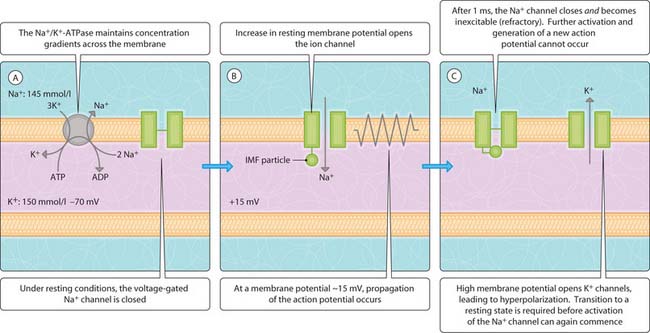9 Local anaesthetics
Nerve conduction
The lipid membrane provides a physical barrier for the movement of ions between the extracellular and intracellular domains of cells including neuronal cells. The Na+/K+−ATPase pump is an energy-dependent protein that pumps Na+ out of cells and K+ into cells thereby creating an electrochemical gradient and a resting membrane potential of –70 mV. Opening of voltage-dependent sodium channels leads to an influx of Na+ into the cell (e.g. nerve) and a rise of membrane potential; this leads to the opening of neighbouring voltage-dependent sodium channels. Once a threshold of 15 mV or greater has been reached, an action potential is generated that results in a wave of depolarization along the length of the nerve. The sodium channel then closes and is refractory to further opening (inactivated state). The membrane hyperpolarizes when potassium channels open, allowing K+ to flow out of the cell and the nerve is refractory to further stimulation. The Na+/K+−ATPase pump then restores membrane potential back to –70 mV and the sodium channel reverts from a refractory to a closed state that is able to be opened by new changes in membrane potential (Fig. 3.9.1). The sodium channel has four domains (D1–D4) each containing six membrane-spanning helices (S1–S6). The S4 membrane-spanning helix of each domain contains positively charged amino acids and serves as a voltage sensor. The S5 and S6 spanning helices are connected by a short membrane-associated loop that serves as the outer pore of the channel, selectively gating for Na+. A short intracellular loop connects S3 and S4 and contains the amino acid sequence isoleucine–phenylephrine–methionine (IMF), which functions as an inactivation gate. The IMF particle is thought to insert into the intracellular mouth of the channel pore and, by binding to a specific site, prevents the entry of Na+ (Fig. 3.9.1).
< div class='tao-gold-member'>
Stay updated, free articles. Join our Telegram channel

Full access? Get Clinical Tree





